on Values, Design, Racing, Ordering, Measuring, & Turning 50
Better values for better tech. . . Simple design improvement. . . Elements of an E Porsche. . . Will consumers order cars. . . Genesis G90 review. . . Heart rates on a race track. . . Designworks turns 50. . .
Optimistic About Autonomy (Of Course, He’s Not Disinterested)
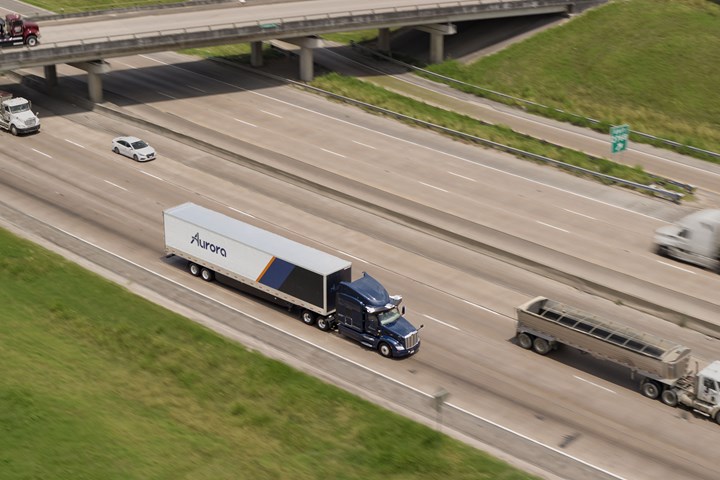
Not only is Aurora developing autonomous tech for applications like commercial trucking, it is also building a culture where jerks aren’t tolerated. (Image: Aurora)
“Over the arc of history, we have witnessed incredible evolution in transportation--from walking, to the horse, to the wagon, to the internal combustion engine, and now electric powertrains. We continue to believe autonomous technology will be the next fundamental change in ground transportation and that Aurora is positioned for success in this new market.”—Chris Urmson, CEO and Co-founder, Aurora, Q3 2022 Shareholder Letter
Aurora is a company developing autonomous tech for vehicles and is working with companies including Volvo Trucks, PACCAR, Toyota, Uber, FedEx, U.S. Xpress, Schneider, Werner, Covenant, and Uber Freight.
The company plans the commercial launch of Aurora Horizon, its autonomous trucking service, by the end of 2024.
Urmson, who had headed Google’s self-driving car program, founded Aurora in 2017 with Sterling Anderson, who had headed Tesla’s Autopilot, and Drew Bagnell, who had led Uber’s autonomy and perception team. (These are all smart guys: Urmson and Bagnell received PhDs in Robotics from Carnegie Mellon; Anderson obtained his from MIT. If a team like this and the people who they work with can’t solve autonomous driving. . . .)
Interesting Aurora Cultural Fact
All companies, large and small, high-tech and bare-bones, tend of have “Value Statements.”
Aurora is no different.
Its values include the obligatory:
- Operate with Integrity
- Focus for Impact
- Celebrate our Diversity
- Rise to the Occasion
- Win together
But then there’s this:
- No jerks
- We work from the assumption that people are good, fair, and honest and that the intention behind their actions is positive. We are intentional in how we communicate and interact, and we hold each other accountable.
Whether Aurora helps bend the arc of history or not with its technology, it is clear that this is an organization with leaders that understand trust is important and jerks are unacceptable.
More companies might take a bullet point from Aurora’s Values list.
///
Sensible Scooter Design
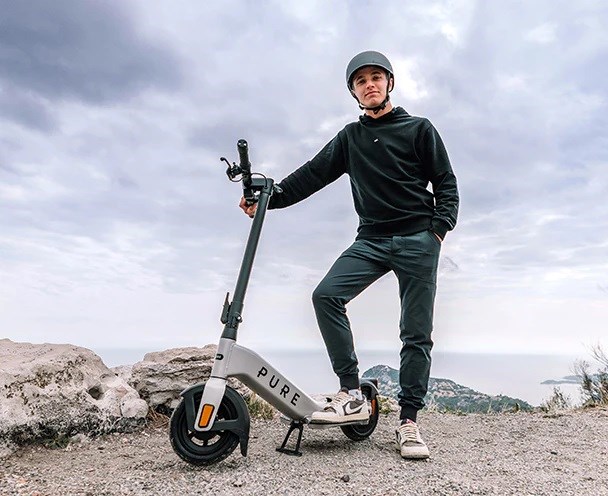
F1 driver Lando Norris and the Pure Advance. (Image: Pure Electric)
Sam Bernard, chief technology officer of Pure Electric, a U.K.-based developer of micromobility vehicles, including e-scooters, makes an interesting point about the designs of many e-scooters:
The long, narrow deck, which has one foot positioned in front of the other, is predicated on the toy kick scooter.
When you’re talking about something that can go up to 15.5 mph, that design isn’t ideal, Bernard suggests.
So the Pure engineering team in Bristol came up with an alternative design for the Pure Advance e-scooter:
There are footpads on either side of the chassis. This provides better balance than having one foot in front of the other.
One of those blinding flashes of the obvious put to good purpose.
Specs
The scooter has a 500-W motor that provides a maximum output of 710 W. The motor is located near the rear wheel, where the weight of the rider is over it. This, Bernard says, helps prevent wheel slip.
The batteries (40 and 50 km range packs) are housed in the main hydroformed tube.
The Pure Advance measures 42.5 inches high, 23.6 inches wide and 41 inches long. It has a mass of 35 pounds. It can be folded to 21 inches by 6 inches by 41 inches.
The e-scooter is expected to launch in March 2023—but will be initially available in the U.K. only.
///
The New Porsche for Formula E
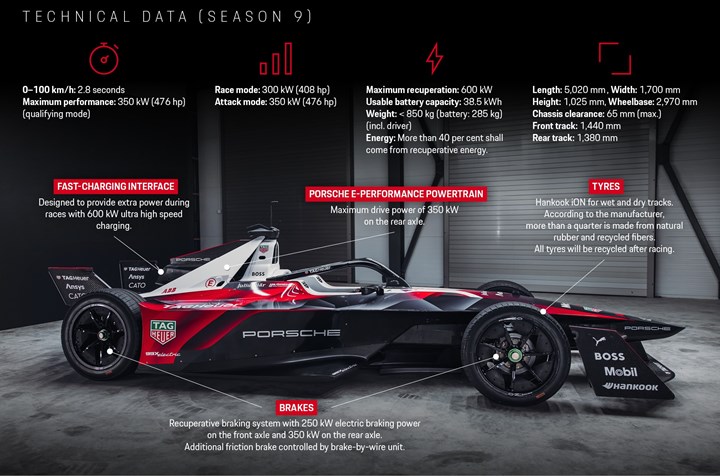
How Porsche made an electric race car made simple. (Image: Porsche)
The picture pretty much says it all about the just-introduced third generation car that Porsche has developed to campaign in the 2023 ABB FIA Formula E World Championship.
The first race for the Porsche 99X Electric Gen3 is the Mexico City E-Prix, which is being held January 14, 2023.
Gen 3 compared with Gen 2 is:
- 20 mm longer
- 38.5 mm lower
- 100 mm narrower
- ~53kg lighter
- 100 kW more powerful
- 350 kW more recuperative braking
A fun fact:
The carbon fiber bodywork for the Gen 3 car is made with recycled carbon fiber from the retired Gen 2 vehicles. That reduces the carbon footprint of manufacturing the new vehicle, Porsche says, by 10%.
///
Build-to-Buy or Build-to-Order?
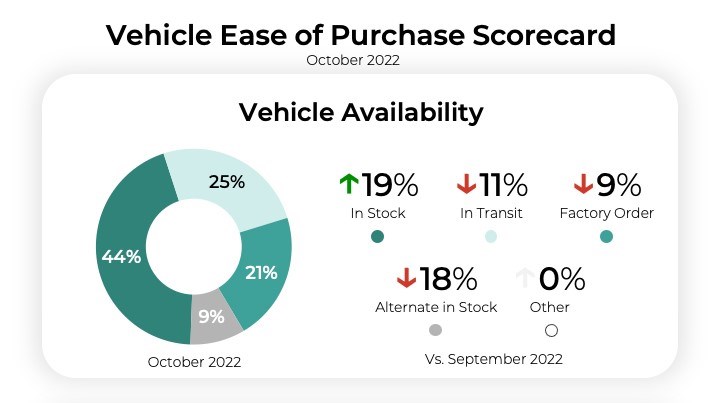
CDK Global analysis finds that more customers are finding what they’re looking for, so it is a matter if you’re a glass-half-full person or not. (Image: CDK Global)
46%. That’s the number, per CDK Global, of people who bought a vehicle in October that was either in transit or from the factory.
In other words, a percentage of people who ordered vehicles.
44% found the trucks or cars they wanted on dealers’ lots.
But CDK Global points out that in September the “consumer-preferred in-stock vehicle availability” (a.k.a., what the customer wants to buy) was 37% so, as they say, 20% (i.e., the increase in October from September) isn’t nothing.
However. . .
For years it has been the case that U.S. vehicle buyers didn’t want to order a vehicle and wait.
This meant that dealers would have plenty of inventory on their lots—and realize that they pay for those vehicles—so that they would have as close to whatever a customer would likely want.
(When they found that there were vehicles that customers didn’t particularly want and throwing in the mats didn’t help, then they’d resort to giant inflatable gorillas to help move the metal.)
Build-to-Order
Given the on-going consequences of the pandemic and the war in Ukraine, both of which have had effects on supply chain (whether we’re talking chip shortages or shipping issues), there is a move by OEMs toward a build-to-order model as the norm.
Sure, there would still be vehicles built for inventory for dealers (the “day supply”).
But for the most part, customers would buy something that would be built to their spec (within reasonable parameters, of course: someone wouldn’t likely be able to get a Silverado or F-150 in chartreuse with purple trim).
It would take longer for the customer to get a vehicle than has been the norm.
But it would save both OEMs and dealers millions in production costs and inventory.
The Questions
While that seems like a reasonable thing to do:
- What happens if an OEM—seeing that the competition is pretty much predicating its build on specific orders, which take weeks or months to fulfill—decides to simply maintain the model of building stock so that their dealers have a massive variety on their lots that can be bought NOW?
Given not only the long-standing vehicle purchase model but more than a little pent-up demand, odds are good that customers would buy those readily available vehicles.
- How long would it take for other OEMs, pressured by dealers who see the store across the street moving sheet metal like mad, to start cranking out vehicles?
- And if build-to-order is something that sticks, what happens to production capacity and the workers who contribute to that capacity?
Let’s face it: Plants have generally been built and equipped to produce more vehicles rather than fewer (e.g., no program manager who wants to have a career is going to shepherd a dud into production, and as hope springs eternal, the projected demand numbers probably err on the generous).
A build-to-order model would probably lead to fewer vehicles being built than has been the case, which means that there is existing overcapacity, which means to right-size would lead to things like unemployment. . . .
Odds are, the giant inflatable producers would only see a lull in the demand for their products.
///
2023 Genesis G90 3.5T E-Supercharger AWD
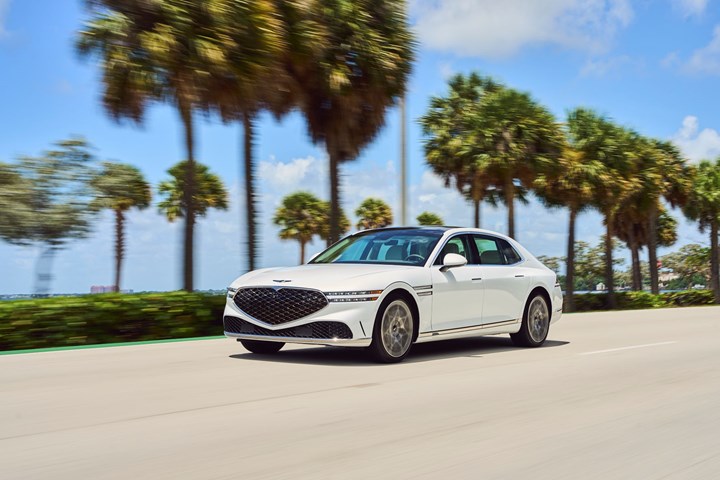
An execution of elegance for driving: Genesis G90. (Image: Genesis)
In the J.D. Power 2022 U.S. Initial Quality Study, which is based on surveys from people who actually own or lease a vehicle, so it is not a theoretical exercise, Genesis is the number-one premium brand.
The ranking is based on problems per 100 vehicles, and a lower number is better.
Genesis scored 156.
The other leading premium brands are: Lexus 157 (close, but. . .); Cadillac 163; BMW 165; Lincoln 167. . .then all the rest of the premium brands are below industry average (180), so as you can see, while Genesis may be the youngest of the premium brands, it is also more than slightly competitive.
You’d Imagine More People Would Know About It
While I had the 2023 Genesis G90, the company’s massively impressive flagship sedan (and, I might add, a massive sedan, with an overall length of 204.9 inches, wheelbase of 124.4 inches, width (excluding mirrors) of 75.4 inches, and height of 58.9 inches)*, I found that people that I talked with were unfamiliar with (1) Genesis or (2) the car (“Is that what Tiger Woods got into his accident in?” No, that was the GV80, an SUV. And he was driving it in relation to his participation in the Genesis Invitational golf tournament. At least the person asking the question was familiar with the marque. Others were at a loss. Perhaps they aren’t PGA fans.)
The Genesis G90 is something that has to be considered more for what it is and offers than what its badge says—for now.
That is, the car considered here has an MSRP of $98,700. Presumably, people who have the financial wherewithal and inclination to buy a sedan in that realm are extremely brand conscious, and let’s face it: No one was ever asked why they bought a BMW (unless it was an i3, but that’s another issue).
But if those people are more brand-agnostic, then the G90 has a whole lot going for it.
Behind the Design
SangYup Lee, the Head of Genesis Global Design Center, and his team have been working to provide Genesis models with a distinctive presence on the road. It is worth knowing that Lee had a stint at General Motors, where he was responsible for the design of the Cadillac Sixteen concept (while most people talked about the V16 engine, the vehicle from 2003, had it entered production even with a V8, would have put Cadillac in a space it is working to return to). He also worked at Bentley, so he knows what luxury is. (It is also worth knowing that Lee penned the fifth-generation Camaro, so he is nothing if not versatile.)
For being a large car, from the front there is a look of litheness, predicated primarily on the “Two-Line” headlamps that flank the grille. While this is probably something no one who is interested in buying a car of this stature would think about, the thin design of the lamps is based on intercrossing the lens of the DRLs with the turn signals and using some 200 micro-optic lenses for the low beams that are integrated with the high beams. The point being: this is serious, modern technology.
While there is a wide expanse of sheet metal on the vehicle side, trim on the front quarter panel echoes the design of the headlamps and there is a subtle shoulder line that starts at the top of the upper trim piece and resolves at the rear where there is, again, stacked horizontal lighting elements.
Drive or Be Driven
One thing you have to realize about the interior: It is designed for those who are drivers and passengers, which seems like a statement of the obvious, but there’s this: the driver might be a chauffer and the passenger someone sitting in the back seat. However, the driver also might be the owner and the passengers, well, passengers. Which is to say that it is fairly sumptuous—leather, wood, metal in tastefully combined abundance—throughout.
Here's an interesting touch. While there is the use, for example, of ash wood for trim, it might seem as though a good-sized copse would have to be harvested to accumulate the wood for a given G90. But Genesis is using “Newspaper Crown Wood” and “Newspaper Stripe Wood” on the interior. You’re not going to find either in your Guide to International Flora. Turns out this is material that is made through the reprocessing of waste paper. Including newspapers. (Which are in process of becoming a rare species.)
Tech Savvy
If you think about smartphones, there is Apple and then there is Samsung.** Samsung is a Korean company. You probably don’t think about Japanese phones or German phones. Mainly Apple and Samsung.
So when it comes to software, infotainment and mechatronics, Genesis, a Korean company, clearly has the technical expertise which it has brought to bear in the G90 in terms of everything from a system that allows pushbutton opening and closing of the doors to a fingerprint recognition system that allows one’s digit to open and operate the vehicle—keyfob-free.
Oh, the Powertrain
It is powered by a 409-hp 3.3-liter twin-turbo V6 (it would be 375 hp but the vehicle driven here has the electric supercharger which adds the extra oomph). It is mated to an eight-speed automatic. The power isn’t G-force inducing—perhaps because the curb weight of the G90 AWD is 4,817 pounds, so there is mass to move.
Here’s the Point
The point is simply this. The Genesis G90 has the stuff that makes it competitive with the better-established brands. Those who put perceived image ahead of actual amenities and execution may miss out on what is something that is truly exceptional.
*To put the size into context, of the other brands in that J.D. Power ranking, the BMW 7 Series is bigger: 212.2 inches long, 76.8 inches wide, 60.8 inches high, and with a 126.6-inch wheelbase. It is proximate to the size of the Lexus LS: 206.1 inches long, 78.8 inches wide, 57.5 inches high, and with a 123-inch wheelbase. Cadillac, dropping the CT6, really doesn’t have anything in this flagship space (the CT5 is comparatively small), and Lincoln no longer sells cars of any configuration in the U.S.
**Yes, there are more handset producers, but who ever talks about them?
///
Abarth and an Electrocardiogram

She looks happy. And as you can see, data is being collected about that smile. (Image: Abarth)
One of the things that OEMs are doing to assure driver awareness when using hands-free driving tech like Ford BlueCruise and GM’s SuperCruise is having cameras that keep an eye on the driver’s eyes.
The simple reason is that these systems, commonly referred to as Level 2+, require that the driver take back control of the vehicle post-haste should something go awry. If drivers reading their emails on their phones or taking a power nap. . .well, the consequences can be bad. So the cameras make sure there is more than a modicum of attention.
The folks at Abarth, the Stellantis performance brand that transforms Fiat 500s into exceedingly hot hatches, wanted to know how drivers and passengers were feeling when behind the wheel.
So they, too, turned to sensors. But different ones.
They equipped Abarth F595, 595 Esseesse and 595 Competizione vehicles with facial recognition technology, and fitted drivers and passengers with a Polar H10 Heart Rate Sensor and Empatica E4 physiological wrist band.
Then, working with a team from Loughborough University, put the cars on the track at Mallory Park, Leicestershire, UK.
In some runs the participants drove the cars. In others there were professional drivers who took the hot laps with the participants in the passenger seat.
Dr. Dale Esliger, reader in Digital Health, Loughborough University, who led the trial:
“The constellation of biometric equipment that we used allowed us to accurately detect an array of emotions that were experienced when drivers and passengers get into an Abarth, while detecting the most prominent emotion during the respective driving activities.”
The data was subsequently analyzed via a DeepFace Python library and Facial Emotion Recognition Library.
Serious stuff, all.
So what did they learn?
- 31.8% of drivers going fast felt happiness, the most prominent emotion. (No word on what the remaining 68.2% of the feelings consisted of.)
- 35.4% of passengers felt happiness during a hot lap. That 3.6% delta between the drivers’ and passengers’ feelings of happiness seems strange. Wouldn’t the person behind the wheel be happier? (Or maybe the passenger was happier that she or he didn’t have to drive so fast.)
The number which is quite curiously low is that measured when the professional drivers were piloting those seriously quick Abarths around the track:
- 11.8% felt “short bursts of fear and shock.”
Having had the opportunity to be a passenger in vehicles driven by professional race car drivers and vehicle development engineering drivers (I will never forget being driven around Circuito Estoril in Portugal by the development driver for the Nissan GT-R), I wonder:
- Did the other 88.2% feel consistent fear and shock?
Why Did They Do This?
“We always knew anecdotally that the levels of joy our cars bring to the driver and passengers, but now we have some preliminary data from one of the word’s leading sport universities to back that up.”—Greg Taylor, Fiat and Abarth, UK Managing Director
Odds are there won’t be ads proclaiming:
“Drive an Abarth 595 Competizione & Know What Fear and Shock Feel Like!”
///
Designworks Golden (Anniversary)
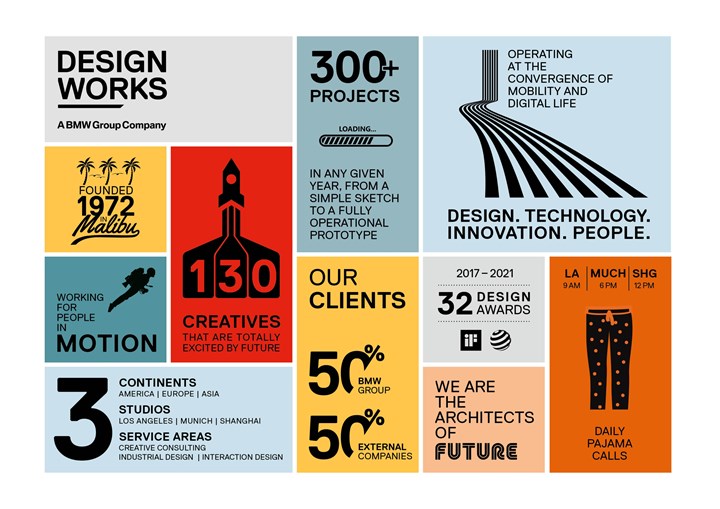
Fun facts about Designworks. (Image: Designworks)
“Advanced design gives us the creative energy we need to be really competitive.”
So says Adrian van Hooydonk, senior vice president BMW Group Design.
He made the comment in relation to the 50th anniversary of Designworks, the industrial design consultancy established by Chuck Pelly in 1972 that has been part of BMW Group since 1995.
Another quote, this from Holger Hampf, who has headed Designworks since 2017:
“We have to challenge the BMW Group in a positive way, develop ideas and, in the best case, answer questions that haven’t even been asked yet.”
Designworks, founded in Malibu, has facilities in Los Angeles, Munich and Shanghai.
There are some 130 team members overall.
How It’s Done
What’s interesting about the way Designworks works is that about half of the 300 projects it takes on every year are for companies not part of the BMW Group portfolio.
Furniture, sporting goods, agricultural equipment—these objects and more are all within its sphere.
So when van Hooydonk talks about obtaining “the creative energy we need to be really competitive,” arguably part of that power is obtained from Designworks’ efforts in spaces beyond automotive.
Going outside what you normally do can be empowering.
RELATED CONTENT
-
Honda to Make Hybrids in Thailand
Honda Motor Co. is preparing to launch production in Thailand of hybrid cars and the batteries that help power them.
-
Revolutionary Hydrogen Storage Tank Design Could Propel H2 Deployment
Rather than storing hydrogen in a large cylindrical tank, Noble Gas has developed a conformal system
-
Aluminum Sheet for EV Battery Enclosure
As the number of electric vehicles (EVs) is about to increase almost exponentially, aluminum supplier Novelis is preparing to provide customers with protective solutions


.jpg;width=70;height=70;mode=crop)






